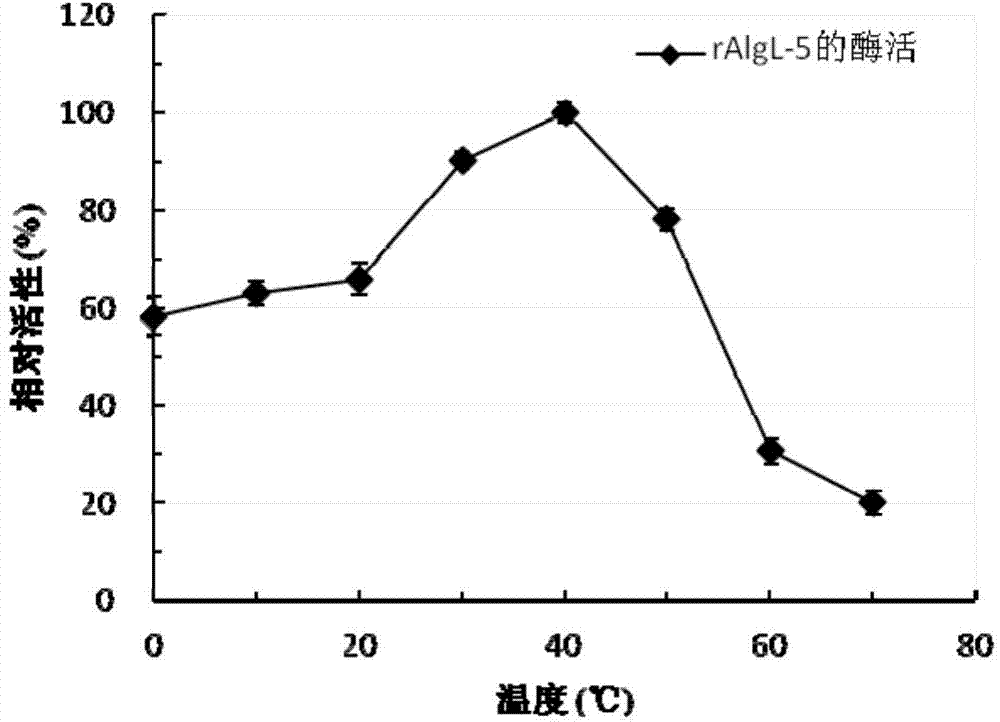Incision-type sodium alginate lyase as well as encoding gene and application thereof
A technology of alginate lyase and coding gene, which is applied in the field of endo-type alginate lyase and its coded gene and application, and can solve the problems of poor activity, rare commercial alginate, low yield of natural alginate, etc. problem, to achieve the effect of stabilizing the properties of the enzyme
- Summary
- Abstract
- Description
- Claims
- Application Information
AI Technical Summary
Problems solved by technology
Method used
Image
Examples
Embodiment 1
[0029] Example 1, Extraction of Flammeovirga yaeyamensis MY04 strain genomic DNA
[0030] Flammeovirga yaeyamensis MY04 was inoculated into liquid medium YT04, and cultured with shaking at 28°C and 200 rpm until the absorbance value at 600 nm (OD 600 ) is 1.2; take 10mL of cultured bacteria, centrifuge at 12,000×g (g, earth’s gravitational constant) for 15min, and collect the bacterial sediment; use 10mL of lysozyme buffer (10mM Tris-HCl, pH8.0) to suspend the bacteria The cells were centrifuged at 12,000rmp for 15min to collect the cell pellet.
[0031] The components per liter of the above-mentioned liquid medium YT04 are as follows:
[0032] Tryptone 10g, yeast extract 5.0g, sodium chloride 30g, water to 1L, pH7.2.
[0033] Add 6.0mL of lysozyme buffer solution to each tube to obtain about 7.0mL of bacterial solution, and add 280μL of lysozyme solution with a concentration of 20mg / mL to make the final concentration of lysozyme 800μg / mL; Place in an ice-water bath for 1.0...
Embodiment 2
[0034] Example 2. Genome scanning and sequence analysis of Flammeovirga yaeyamensis MY04 strain.
[0035]Genomic DNA prepared in Example 1 was scanned and sequenced by Shanghai Meiji Biotechnology Co., Ltd. using pyrosequencing technology. The DNA sequencing results were analyzed with the online software of NCBI (National Center for Biotechnology Information, http: / / www.ncbi.nlm.nih.gov / ) website. The analysis software used on the NCBI website is Open Reading Frame Finder (ORF Finder, http: / / www.ncbi.nlm.nih.gov / gorf / gorf.html) and Basic Local Alignment Search Tool (BLAST, http: / / blast.ncbi.nlm.nih.gov / Blast.cgi).
[0036] The results analyzed by the above-mentioned biological software show that the genomic DNA of the Flammeovirga yaeyamensis MY04 strain carries a coding factor algL-5 of alginate lyase, and the coding region of the gene algL-5 is 1701bp long, and the nucleotide sequence is as follows: Shown in SEQ ID NO.1. The alginate lyase AlgL-5 encoded by the gene algL...
Embodiment 3
[0037] Embodiment 3, the recombinant expression of gene algL-5 in Escherichia coli BL21 (DE3) bacterial strain
[0038] Using the genomic DNA prepared in Example 1 as a template, PCR amplification was performed. The primer sequences are as follows:
[0039] Forward primer AlgL5-F: 5, -C GGATCC GATGAACAACCAGTACAATG-3' (BamH I);
[0040] Reverse primer AlgL5-R: 5'-G CTCGAG GTGACTTACTTTTAGGTAAC-3' (Xho I);
[0041] The underlined mark in the forward primer AlgL5-F is the restriction endonuclease BamH I site, and the underlined mark in the reverse primer AlgL5-R is the restriction endonuclease Xho I site. The high-fidelity DNA polymerase Primerstar HS used was purchased from China Dalian Biotech Co., Ltd., and the PCR reaction reagents used were operated according to the product instructions provided by the company.
[0042] PCR reaction conditions: pre-denaturation at 95°C for 4min; denaturation at 94°C for 40s, annealing at 60°C for 40s, extension at 72°C for 110s, 30 cyc...
PUM
 Login to View More
Login to View More Abstract
Description
Claims
Application Information
 Login to View More
Login to View More - R&D
- Intellectual Property
- Life Sciences
- Materials
- Tech Scout
- Unparalleled Data Quality
- Higher Quality Content
- 60% Fewer Hallucinations
Browse by: Latest US Patents, China's latest patents, Technical Efficacy Thesaurus, Application Domain, Technology Topic, Popular Technical Reports.
© 2025 PatSnap. All rights reserved.Legal|Privacy policy|Modern Slavery Act Transparency Statement|Sitemap|About US| Contact US: help@patsnap.com



